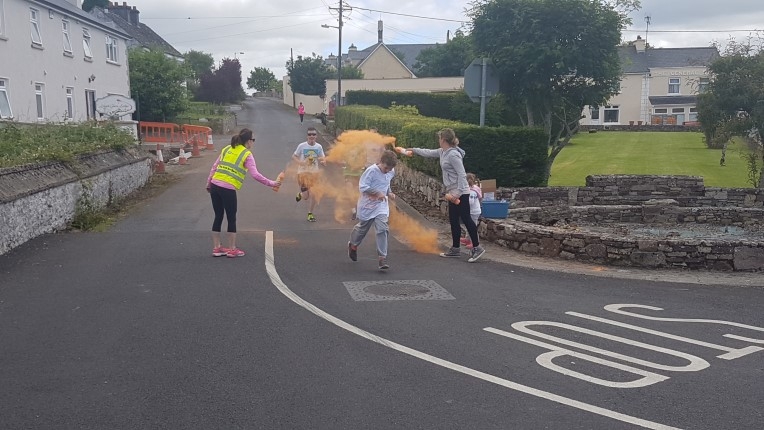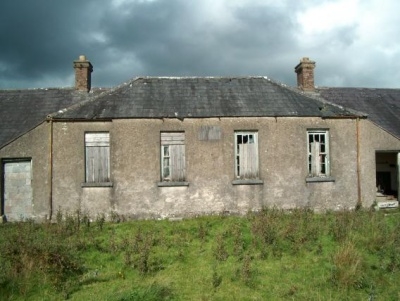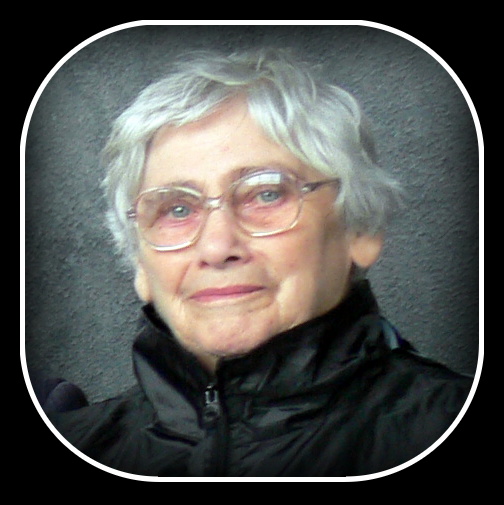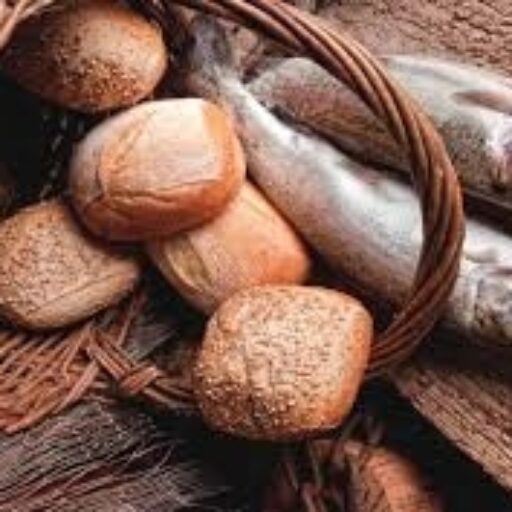
by Vincent | Jun 24, 2017 | General Interest, Humour
Earlier today I was in Monasteraden, in the midst of old friends and neighbours for a special Fundraiser for St Aidan’s N.S. It was a 5K Run/Walk with a difference. After each Kilometer travelled, the “participants” were coloured. The idea being that at the end of the 5k, they would be multi-coloured. Sadly I was in a bit of a rush as I had another commitment in my own parish but I was very happy to be there. It was nice to be asked to start the race. Not sure how it finished but the atmosphere was good. Well done to all involved.

by Vincent | Jul 6, 2016 | General Interest, Reflections, Religion, homily

Coolavin National school was built in 1871. There were 2 sections – Boys and Girls. It probably replaced the old Monasteraden Boys’ and Girls’ schools.
In 1936 the boys and girls schools became one and in 1967 pupils from Townaghbrack National School which closed, transfered to Coolavin.
Coolavin N.S. closed its doors for the last time in December 1973 and the pupils and teacher Teresa Murtagh moved to the new St. Aiden’s N.S.
The following staff are recorded John Casey, Mary Coleman, Winifred Casey, Nora Teresa Lavin, Kate Flaherty, Bridie P. Jackson, Mary Kate Corcoran, Miss M. Spelman, Hannah Tynan, Catherine Casey, Mary Finnegan,
I spoke with Pat Hunt (via email) in recent days. We talked of Joe Spelman and Bishop Brendan’s homily and the “appreciation” he mentioned that had been written about Fr Joe’s mother (R.I.P. them both) following her death in 1982. I am fairly confident I have a copy of that somewhere but most likely filed, like lots of my bits and pieces, under “I don’t know where!!”. Pat told me he’d send me the words. A man of his word, he did! I will include them here. They were written by Mary Corcoran whose Funeral Mass I celebrated in Monasteraden in February 2015. God Rest them all. Thanks to Pat Hunt for sharing these words with me again ..
https://sherlockshome.iemary-corcoran-r-i-p/
LATE MRS M. SPELMAN
(An appreciation by an ex-Pupil)
I was five years old when I first met Mrs Spelman. She was the Infants’ teacher in Coolavin School and she travelled daily by train from Ballaghaderreen to Island Road Station. There,the “big girls” took her bag leaving her two hands free to clasp the “wee ones” as she called us in her softly slightly northern accent.
For those of us venturing out to school for the first time her hand had a comforting feel as we trotted the half mile to school. To get to the Class Room we had to pass through the “Big School” — and while Mrs Spelman was allowed the short cut across the hearth flag, we crept silently round the room under the baleful glare of the “the Mrs” — whose specs on the end of her nose, seemed to give her the ability to see in all directions simultaneously. Once inside the Class Room door we were safe. With chalk, slates, pencils, ball-frames, plasticine, she taught us all that we were able to learn. If we were bright, we earned her smile and a pat; if we were slow, we earned a bit more of her time and patience, but if we were bold, we earned her frown and her disappointment but never, ever her anger.
Above all she taught us how to pray. Such was her fervour and devotion that it wasn’t unknown for people outside of school to ask for her prayers in time of trouble. Preparation for first Holy Communion wasn’t just intended for one particular Whit Sunday, rather did it lay the foundation for devotion to the Blessed Sacrament for the rest of our lives. We left her room after two years, but we never left her thoughts and prayers.
I met her again just two weeks ago. Though in her late 80s, she bubbled with joy and welcome and for a couple of hours we travelled “Bóithrín na Smaointe”. Only a few days later the “two boys” (as she fondly called her sons Frs Jo and Jerry) took her for a trip around her beloved Coolavin and Monasteraden, where she renewed many old acquaintances. A few days later she returned to Dublin to her daughter. There she died.
True, she never won any Captain’s prize on the golf links nor was she the president of any organisation. Neither did she receive any public recognition when her thirty years in Monasteraden came to an end, but she carved a niche in our hearts that will last forever. As I left Kilcolman graveyard on Wednesday, the prayer of the Bishop as he blessed the coffin kept coming back to me, “May the Angels lead you into Paradise and may the saints and martyrs greet you at your coming” — for they don’t come like Mrs Spelman any more.
M.C.
Mrs Spelman died on 29th August 1982

by Vincent | Feb 23, 2015 | General Interest, Reflections, Parish and Diocese, Religion
On Sunday, February 22nd 2015, I celebrated a Funeral Mass in Monasteraden. The Mass was for Mary Corcoran who had died a few days earlier. I’ve known Mary all my life and came to know her very well during the years I worked in Ballaghaderreen Parish where I had special care for the Monasteraden area of the parish. Mary played the organ in the church and had an involvement in the choir for something in the region of eighty years – from her childhood days. Her commitment was remarkable. I was asked to be Principal Celebrant at her Funeral Mass and was honoured to accept that invitation and thankful to the priests of the parish and others who joined with me for the Mass – not least Fr James Sharkey, SPS, a cousin and lifelong friend of Mary. I am going to share here the words used at Sunday’s Mass. I know Mary read this blog and I hope she approves of the inclusion of these words in her memory. In so doing, I offer my renewed sympathy to her son Michéal, daughters Noreen and Marie, to her sons-in-law, daughters-in-law, her grandchildren and Mary’s neighbours and friends. I remember too, her son Philip, R.I.P. who died in June 2012.
Mary Corcoran died! I think that’s what she’d expect me to say today. Not so sure she’d talk about having “passed” or “slipped away” – no she’d say “died”, “dead” …. I remember writing in August 2009 “my mother died” – they were three words with just twelve letters but the brevity of their content didn’t reflect the enormity of their significance. No less so for Mary’s children and their families here today. This is a life-changing moment. I don’t think she’d want it sugar coated or downplayed. We are here because Mary Corcoran died.
And here we are! We gather to say our prayers – with face to the Altar and back to the gallery. Both places of huge significance for Mary. It was at this Altar she was baptized, received Eucharist for the first time, stood beside Billy as vows were exchanged, brought her four for baptism, bade farewell to Philip – here she found strength for the journey, the faith to carry on and the gift to believe. It’s certain this is where she wants to be right now – placed at the foot of this Altar so that prayers can be offered, memories evoked and thanks can be said.
The gallery too, in full voice and sound today re-echoes her countless notes played and sung in praise of his name. The twelve letters I wrote in August 2009 and the eight notes of the octave, have in common the ability to take us elsewhere. A church without music is an impoverished church. A liturgy without music, though remaining liturgy, lacks a central element. Mary ensured that was not to be the story in Monasteraden. Faithfully she climbed those steps, turned on the music, shared the notes and encouraged song. She walked up and, I believe backed down but between the walking and the backing she made music happen and this church has been the better of that. It’s great to hear that sound here again today. Long, long may it be heard when “two or three” gather in His name!
I read somewhere during the week “Repent, so that the preacher doesn’t have to tell lies at your funeral”!! I’m not here to tell lies. I believe Mary Corcoran was a good woman. Direct! For sure!! More than once she let me know when I got it wrong but many times more than once she let me know when I got it right! She had a directness that was rooted in love of place and was always well intentioned. She did not like to see anything diminish the place and “people make places” so, in many ways, she didn’t like anything that diminished people – her people (family), neighbours and the Church. There’s a line in Scripture that speaks of “Zeal for your house consumes me” and I think it’s a line that ran deep in the veins of Mary. We need people like that and we’re impoverished without them.
So here we are, in this Gospel moment – a meal has just been shared and the penny has dropped. These two men have been walking the road and sharing a meal with Jesus. It’s when he’s gone the fullness of that reality dawns. We sometimes refer to this Gospel passage as the “Road to Emmaus”. Lately I’ve been thinking of it more in terms of the Road from Emmaus. The road to it is one thing but the road from it another. Where do we go when the truth has dawned? What do we do with and about that truth? The men in the story re-traced their journey and told their story to those to whom they felt it would make difference so that they could tell it to others.
I think that’s where we are now! Mary lived for almost ninety years. She travelled but most of her travelling was local. Walking, cycling or driving – her destination was quite often where we now gather – St Aidan’s Church. She rejoiced with people on happy days and shared their grief on days of sadness. She brought her family here and taught them how to pray. She heard hymns she liked and took them to the gallery (the odd song too!! “Isle of Inisfree!”). She lit candles in the quietness of this Sacred Space and, in their flicker, remembered the dead and the living (I’m humbled to say, me among them). She remained faithful when many, for a variety of reasons, walked away from Faith and practice. This is where we are. Mary’s road to Emmaus led her to encounter and recognise the Lord, even in the darkness of her son’s illness and death and to find strength for the journey.
Where to for her son, daughters and their families today? Where to for the choir? Where to for neighbours and friends? Where to for all of us from this moment? We can’t be sure where the road will take us but we can be sure we’ll not walk it alone. Let all that was good in Mary be recalled? Let the Faith loved by Mary be lived and let the song sung by Mary lead us to the chorus:
“With him, I am risen” …. May she rest in peace. Amen.

Mary Corcoran, R.I.P.
![Felicity MacDermot (Funeral Mass Homily)]()
by Vincent | Mar 30, 2012 | General Interest, Reflections, Religion
 I am just home from the Funeral Mass for Felicity MacDermot. It was celebrated in St Aidan’s Church, Monasteraden and a large congregation was present, Concelebrants included Bishop Thomas Flynn, (Bishop Emeritus of Achonry), Monsignor John Doherty (formerly served in Monasteraden and in the Cathedral as Curate and Administrator), Fr Dan O’Mahony, Cloonacool and the two serving priests in Ballaghaderreen Parish (of which Monasteraden in a part), Fr Joseph Gavigan and Fr Martin Henry. I had been asked a few weeks ago to celebrate the Mass in the event of Felicity’s death and was honoured to do so.
I am just home from the Funeral Mass for Felicity MacDermot. It was celebrated in St Aidan’s Church, Monasteraden and a large congregation was present, Concelebrants included Bishop Thomas Flynn, (Bishop Emeritus of Achonry), Monsignor John Doherty (formerly served in Monasteraden and in the Cathedral as Curate and Administrator), Fr Dan O’Mahony, Cloonacool and the two serving priests in Ballaghaderreen Parish (of which Monasteraden in a part), Fr Joseph Gavigan and Fr Martin Henry. I had been asked a few weeks ago to celebrate the Mass in the event of Felicity’s death and was honoured to do so.
Many of Felicity’s family and friends took part in the Liturgy and were involved in reading from the Scriptures, bringing forward the offertory gifts (including a Bible that belonged to her late husband), the Prayers of The Faithful and, her grand-niece Siobhan, assisted with the distribution of Holy Communion. A eulogy was given. The local choir and guests provided the music. The Principal Teacher in the local primary school, Ms Ann Moriarty, played a solo violin piece “Miss MacDermot” by O’Carolan.
Below are the words shared during the homily at the Mass – the Gospel text was the story of the Annunciation.
I can’t pretend today to know much about the history of Felicity’s life. That is not her fault for, on occasion, she’d tell me something about her father and mother or her native place. She’d tell me things about Monasteraden and Coolavin, about reliquaries and relics, about former bishops of Achonry and priests who stood where I stood before me. She had, of course, a purpose in her telling since she valued words a great deal and was agile in their usage and careful in their allotment! Fewer was often better but the intention was to get a message across. The fact that I can’t go into detail reflects more on the hearer than the speaker. That said, I enjoyed listening to her and, truth told, valued what I heard. It’s just that history, like many other things, isn’t one of my strong points. Felicity valued the message – the story received, lived and shaped, and to be passed on. To that end, her nephews and nieces were and remain a central part of her life. For the story of your family, heard by her, lived and shaped by her, is today left at your feet, embedded in your hearts that you too may take it, shape it and pass it on. Of this, I’m sure – she’d want nothing less and ask nothing more.
Death came to Felicity on Monday morning, March 26th and given that March 25th fell on a Sunday this year, the celebration of the Solemnity of the Annunciation was transferred to the Monday. She died on the day the Church celebrated Mary’s “Yes”. It was a difficult yes, insofar as it meant change of a life plan, the risk of wagging tongues and the uncertainty of motherhood at a young age. Mary found that “yes” nonetheless and, having found it, never went back. It was a yes to the unknown that is rooted in Faith. Aware of her Jewish story, Mary knew that the Messiah had to come and that whatever that involved could not and should not be held back. If her part in that “coming”, involved self-sacrifice and uncertainty, then so be it. “Amen – let what you have said, be done”.
There’s one word in that Gospel passage that has struck me this year, possibly in a way it never did before. Might it be something to do with visiting Felicity in hospital and knowing that she couldn’t speak and knowing, that in our communication, there would be no verbal response? I really don’t know. The word I’m thinking of is the word “Listen”! Gabriel used it, in a gentle way, to let Mary know there were words to be spoken and response would be needed. It was, in some ways, a call to reflection. Mary listened, as she often did in the Scriptures, and pondered in her heart. I think it likely there was a fair degree of pondering in Felicity’s life, not least in the past few weeks since the visitation of illness. What did she hear?
She heard of course the voices of doctors and nurses as they tended to her. She heard and recognised the familiar voices of family and friends – neigbours from Monasteraden – and all who called to see her. She responded, to the end, with a beaming smile. She heard prayers being offered, “This is the Lamb of God who takes away the sins of the world ….. “, she heard the great words of absolution “through the ministry of the church may he grant you pardon and peace …” she heard other patients and their visitors. She listened, reflected and, I feel certain, responded. There was, I’m sure, a smile here – a tear there – but always response.
How can I be so sure she “listened”? I think it’s something to do with the fact she always seemed to listen to the goings on around her, read what we call “the signs of the times” and respond. In recent days I came across a number of letters she wrote to the national newspapers, especially the Irish Times and Irish Independent. The topics were varied – wondering why the government was seeking tenders, from other countries, for the construction of polling booths for elections. She suggested children in woodwork classes or those on FÁS training programmes could easily make these but wondered if this solution were “too simple”? I’d say she felt Clogher Hall could produce as good a polling booth as Copenhagen! Another spoke about Bishop Eamonn Casey and the endless tirade of articles and comments around his life. She wondered was there any room to acknowledge the good he had done, not least with young emigrants in London? Again, a listening that brought with it a willingness to speak against popular opinion. She had a lovely line about rural transport, in another letter, and about matrons running hospitals in which they also worked. She concluded, “of course that was when we were a people not an economy”. She wrote about seagulls and how she missed their sound when her neighbours cut the silage. For a while she didn’t realise what she was missing in the silence but then it dawned – the gulls were gone. She blamed the mink! Yes, Felicity listened and responded.
Perhaps they’re the two words we might take from her Funeral Mass today – listen and respond. Listen to what’s said, to what’s happening – locally and globally – and respond. She had a lovely way of responding. I remember one Sunday after Mass, she shook my hand in the porch, smiled and said “you’re the third glorious mystery”. I wasn’t expecting that and I think I was at her gate on the way back to Ballagh when I realised it was the “descent of the Holy Spirit”. She was saying to me she heard what I said, felt it was worth saying and wanted me to know that. Yes, she had a lovely way of responding.
I started off by saying I can’t claim much knowledge of Felicity’s history but I have an awareness of her geography. Her geography was rooted in Coolavin, Monasteraden and South Sligo. She loved this place and, of that love, much was born. How many schemes were secured with her signature? How many ideas now clearly visible were born of her imagination? How many dreams, now realised, are the direct fruits of her energy and commitment? We need not travel far, in any direction, from this church to find reminders of her life. Her geography is here. We are the men, women and children of that geography and today – in her memory, we seek to make it our own, to live in it, respect it, be shaped by it, add shape to it and hand it on to those younger and yet to be born. Her Geography was steeped in and enriched by her love for the world, its people and above all its Creator. All of these must be included in our co-ordinates of being as we journey onwards from this moment.
If she thought, even once, that I was the third Glorious mystery – then it’s fair to say she continually spanned the mysteries. There’s a bit of the first Joyful here today – Annunciation, a lot of the second, as she looked out for people in the Visitation and certainly there were many occasions of Presentation in the Temple and Finding in the Temple. Yes, her life dipped into the sorrowful mysteries too – losing her husband over thirty years ago, she carried her cross and I suspect knew moments of pain and sorrow in the garden of life but today there’s a Fourth Glorious mystery to rejoice in and draw comfort from – a moment of Assumption, being brought home and given a well-earned place in God’s presence.
Listen! You have won God’s favour.
May she rest in peace.






